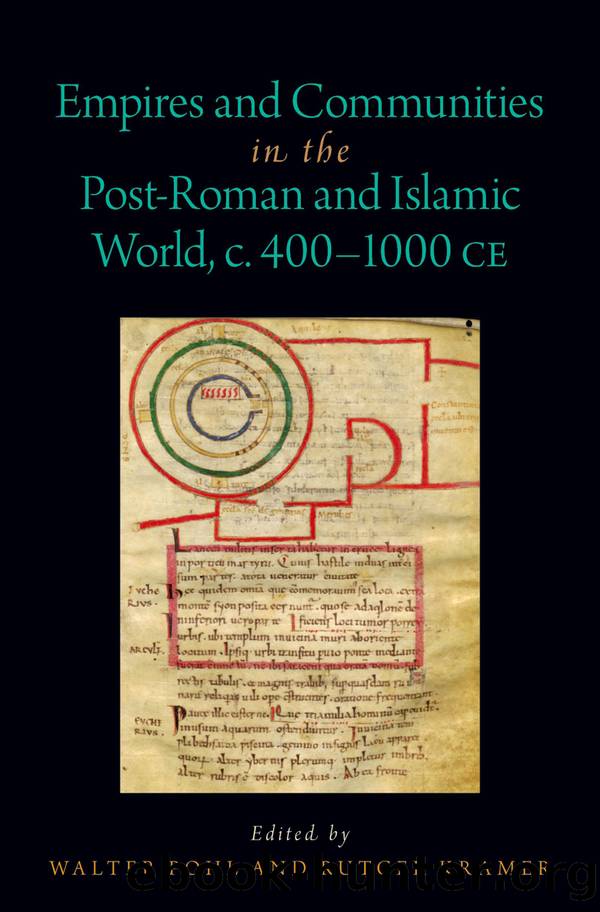Empires and Communities in the Post-Roman and Islamic World, C. 400-1000 CE by Walter Pohl;

Author:Walter Pohl;
Language: eng
Format: epub
Publisher: OUP Premium
Published: 2021-06-15T00:00:00+00:00
9
Diversity and Convergence
The Accommodation of Ethnic and Legal Pluralism in the Carolingian Empire
Stefan Esders and Helmut Reimitz
Around the year 820, almost two decades after the renovation of the Roman Empire under Charlemagne and some years after Charlemagneâs son Louis the Pious had taken over the rule of the young empire, Louis received a letter from the archbishop of Lyon, Agobard. In this long letter, the archbishop complained about the âgreat diversity of lawsâ that he had observed ânot only in different regions and cities, but even in many homes.â According to the bishop, it occurred quite often that âfive people are walking or sitting together and not one of them shares the same law with another (nullus eorum communem legem cum alterum habeat).â1 For Agobard, this was not the correct constitution for a Christian empire. Quoting from Paulâs letter to the Colossians, he emphasized that the Christian vision of community had erased older distinctions between diverse peoples. Christ had inspired a community where there was âneither Gentile nor Jew, circumcised nor uncircumcised, Barbarian nor Scythian, slave nor freeâ (Col. 3:9â11). This was still true for the Carolingian Empire, where there should also be no distinction between the different communities and peoples that had come to live under Carolingian rule (âneither Aquitanian nor Lombard, Burgundian nor Alamanâ).2 After a few more quotations from Paul, mostly from his letters to the Corinthians, Agobard comes back to the issue of legal pluralism and asks the emperor whether the great diversity of laws in the Carolingian Empire was not something that would stand in the way of the great divine work of unity.3 The emperor should finally establish just one law for the whole of the Christian community in his empire.
The fundamental arguments of Agobard, however, had a very specific context. The letter did, in fact, respond to laws that the new emperor Louis had issued shortly before, in 816 and in 818/819. Like most of the legislation of the Carolingian emperors, the decree was sent out as a capitulary, a list of royal directives organized in capitula (chapters).4 Louisâs capitularies of 816 and 818/819 were actually relatively long collections of chapters that were issued as additional capitula to the different laws of the Carolingian Empireâas capitula quae nobis addere placuit.5
These different laws present a highly diverse evidence of legislation and legal traditions. Most of them had grown out of the quite different milieux of the late Roman world and present various mixtures of Roman and non-Roman legal norms and practices.6 After the dissolution of a centralized Roman government in the Western Empire, which had included some of these laws within an imperial framework, these lawsâ relationship to one another had to be defined in new ways. In order to adapt to the absence of an imperial legal structure, the different successor states of the Western Roman Empire introduced new laws and new forms of legislation, next to older laws and law codes (including the norms, traditions, and practices of Roman law).
The accommodation of
Download
This site does not store any files on its server. We only index and link to content provided by other sites. Please contact the content providers to delete copyright contents if any and email us, we'll remove relevant links or contents immediately.
| Africa | Americas |
| Arctic & Antarctica | Asia |
| Australia & Oceania | Europe |
| Middle East | Russia |
| United States | World |
| Ancient Civilizations | Military |
| Historical Study & Educational Resources |
The Battle of Mogadishu by Matt Eversmann & Dan Schilling(698)
The Confidence Men by Margalit Fox(649)
The Spymaster of Baghdad by Margaret Coker(619)
A History of the Muslim World since 1260: The Making of a Global Community by Vernon O. Egger(615)
Jack the Ripper and the East End by Peter Ackroyd(583)
Empire of Fear: Inside the Islamic State by Andrew Hosken(564)
The Afghanistan File by Prince Turki AlFaisal Al Saud(549)
The Crimean War by Winfried Baumgart(543)
Akhenaten by Dominic Montserrat(535)
Islam At The Gates: How Christendom Defeated the Ottoman Turks by Diane Moczar(530)
The Jerusalem Diamond by Noah Gordon(530)
A Concise History of Greece (Cambridge Concise Histories) by Richard Clogg(527)
The History of Jihad by Robert Spencer(525)
Beirut 2020 by Charif Majdalani(514)
Israel: Ancient Kingdom or Late Invention? by Daniel I. Block(511)
Enemy in the East by Rolf-Dieter Müller(506)
The Privatization of Israeli Security by Shir Hever(500)
Destroying a Nation: The Civil War in Syria by Nikolaos van Dam(492)
The Nine Lives of Pakistan by Declan WALSH(490)
